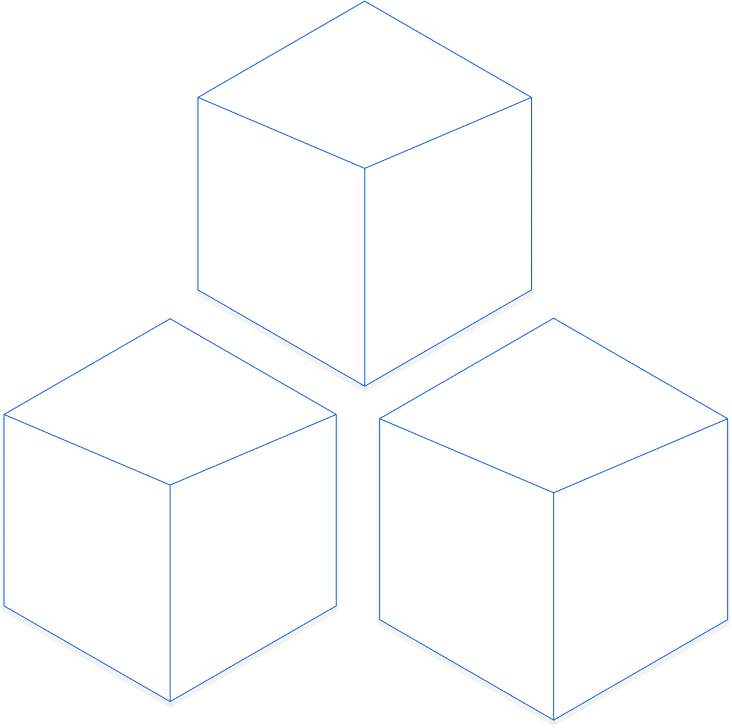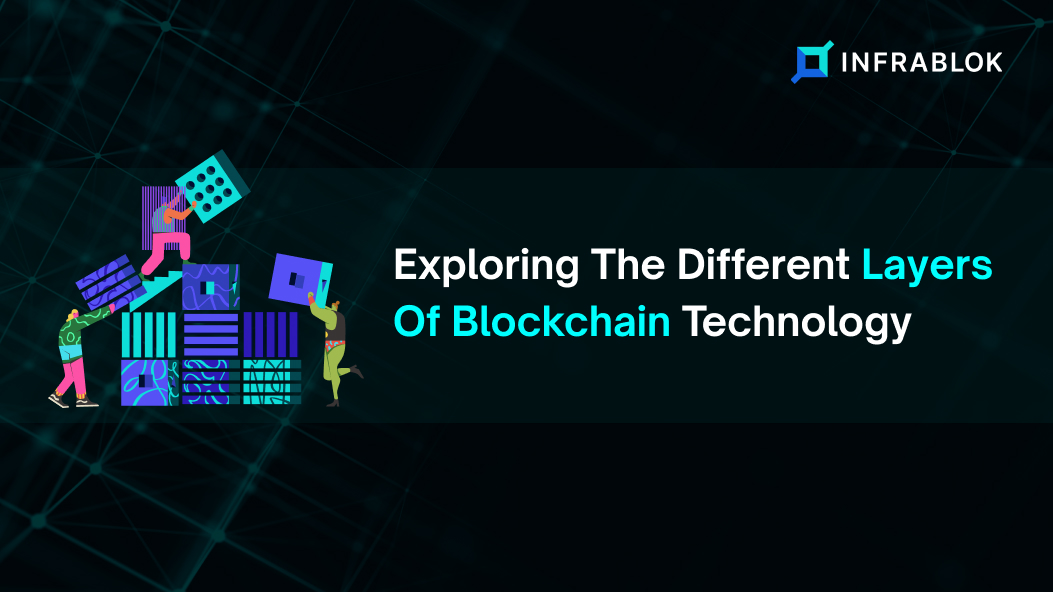In 2021, worldwide spending on Blockchain solutions was predicted to reach $6.6 billion. As Blockchain solutions become more prevalent in the coming years, spending is expected to reach $19 billion by 2024.
Blockchain technology is a decentralized digital ledger created with blocks that form data across a peer-to-peer (P2P) network. Once data is stored on this ledger, it becomes near unattainable to delete, modify and hack. In fact, this unique characteristic of Blockchain has inspired many to build Blockchain-based projects for their businesses.
However, before pondering how the Blockchain can be utilized in your business, you must first understand how it works. To take advantage of Blockchain technology fully, let’s examine Blockchain layers.
The Structure Of Blockchain Layered Architecture
Blockchain technology is built on a layering architecture. It is divided into various layers, where each layer serves a specific purpose. At its core, all the layers work together to provide a secure, reliable, decentralized layered network called Blockchain.
Let’s explore the various layers that make Blockchain technology work –

1. Infrastructure Or Hardware Layer
It is the first layer of the blockchain network that consists of network and data servers. It consists of data servers that securely store the data of the Blockchain. Blockchain follows peer-to-peer (P2P) network architecture where each node is connected to every other node in a network.
But this network is distributed across the globe, making it decentralized. Sharing of data is quick and easy because of this P2P architecture. It is done by following the client-server architecture approach. Thus, a distributed ledger is constructed where a node communicates with another node and is allowed to randomly check the transactional data.
When a blockchain dApp sends a request to the data server for access, it connects with the peer client in its P2P network, letting the exchange of data with each other. The transactions in this network are computed, validated, and recorded in an organized way in a shared ledger creating a distributed database.
2. Data Layer
It is the second layer of blockchain technology and is responsible for storing and organizing data on the Blockchain. It uses a linked list of blocks to arrange the transactions, and when a certain number of transactions are authenticated by nodes, the data is clubbed into a block. This block is uploaded to the Blockchain’s linked list as a new block and linked to the previous block. If it’s the first block in the list, then there can be no linkage to the previous block; in this case, it is known as the genesis block.
Each block in the Blockchain has the Merkle tree’s root hash along with the previous block’s hash, timestamp, nonce, and block version number. This information in each block guarantees the Blockchain’s security, integrity, and irrefutability. All transactions in Blockchain are digitally signed by the private key of the sender’s wallet and are known as finality.
Every transaction on the block is signed digitally with the private key from the sender’s wallet. Since this key is only available to the sender, data can’t be tampered with by anyone. This step is termed “finality”. The data is also protected by the digital signature that protects the owner’s identity, which is encrypted for security reasons.
Layers Present In Data Layer
The layers in the data layer of a Blockchain can be categorized as follows –
- Data Storage Layer – This is the layer that actually stores the data on the Blockchain. It can be implemented using various distributed ledger technologies, such as a distributed hash table or a directed acyclic graph. An example of a distributed ledger technology used in Blockchain networks is the Blockchain itself, which stores transactions and blocks in a chain-like structure using cryptographic hashes to ensure the integrity and security of the data.
- Data Organization Layer – This is the layer that organizes the data on the Blockchain in a way that is easy to access and retrieve. This can be accomplished using indexing systems or data structures that allow for efficient data storage and retrieval. An example of a data organization layer in a blockchain is the Merkle tree, which is a data structure that enables efficient verification of large amounts of data.
3. Network Layer
It is also known as the P2P layer or propagation layer that does inter-node communication. The transaction on the Blockchain is carried out by nodes. P2P helps nodes in a network detect other nodes to make inter-node communication easy and quick.
Moreover, it lets multiple nodes transmit transactions to settle an agreement on the transaction’s legality. It handles block generation, node detection, and block addition in the blockchain network.
4. Consensus Layer
The most vital layer out of all the layers on the Blockchain is the Consensus layer. This layer holds the major responsibility that is authenticating transactions. If this layer fails to authenticate the transaction or does not do it correctly, then the whole system will fail. It implements the protocol to validate transactions that are based on some complex mathematical formula that needs a certain number of nodes to validate that single transaction.
Thus, several nodes process every transaction when the required number of nodes reach the same conclusion and agree to its legality. Thereafter the transaction is validated, making it a decision based on the consensus mechanism, where no single node has control, therefore, maintaining the decentralized characteristic of Blockchain.
At any given time, multiple nodes are processing transactions, bundling them, & adding them to the Blockchain, which may result in the generation of several blocks at the same time resulting in a blockchain branch. But the consensus layer ensures that only a single block is added at any given time to the Blockchain and addresses all the disputes related to it, enforcing uniformity of the network.
Examples Of Consensus Algorithm
A couple of examples of consensus algorithm used in Blockchain is –
- Proof of Work (PoW): This is the consensus algorithm used by the Bitcoin Blockchain. It requires nodes to solve a complex mathematical problem in order to validate new transactions and create new blocks. The first node to solve the problem gets to add the new block to the Blockchain and is rewarded with Bitcoin.
- Proof of Stake (PoS): This consensus algorithm allows nodes to “stake” their tokens to validate new transactions and create new blocks. The more tokens a node stakes, the higher the chances of it being chosen to validate a new block.
5. Application Layer
It is the topmost layer of the Blockchain network stack where decentralized applications (dApps), smart contracts, etc., interact with the users via scripts, APIs, user interfaces, and frameworks. Users can perform any action at this layer, like buying or selling a cryptocurrency or NFT, tracking transactions over the network, tracking the supply chain, securely voting, etc.
Additionally, the protocols in this layer are subdivided into application and execution layers. End-users utilize the programs at the application layer to communicate with the Blockchain network. The application layer then gives instructions to the execution layer to execute the transaction, ensuring that the deterministic nature of the Blockchain is maintained.
Examples of applications built on the Application layer are cryptocurrency wallets, decentralized exchanges, and prediction markets, to name a few.
Different Layers Of Blockchain Protocols
Another way to understand Blockchain technology is by knowing the different layers of Blockchain protocols. The blockchain network comprises four layers, as follows –

Layer 0
It is a base of the Blockchain ecosystem on which the rest layers are built and is often referred to as the Blockchain itself. It consists of the network and all its components (physical infrastructure and hardware) that work together to make the blockchain function.
The solutions provided at this layer are compatible with the scaling solutions of Layer 1 and Layer 2. In addition, this layer supports the functionality of cross-chain communication or inter-chain operability. The native token of respective chains belongs to this layer.
Some examples of Layer 0 are Bitcoin, Ethereum, Polkadot, Avalanche, Cardano, Cosmos, etc.
Layer 1
It consists of the protocol or architecture that defines how the blockchain network operates. It carries out tasks like resolving disputes, consensus mechanisms like proof-of-work or proof-of-stake, protocols, and constraints.
Layer 1 can validate and finalize transactions on its own. Blockchains at Layer 1 have their own native token, known as a coin, which is used to pay transaction or gas fees. It symbolized the actual Blockchain.
Tasks that are required to be solved in this layer give rise to the Blockchain’s scalability issue. Any increase in the Blockchain means higher computational power required to solve & add blocks in the Blockchain, resulting in high fees and longer processing times.
Some examples of Layer 1 are Bitcoin, Ethereum, Binance, and Solana.
Layer 2
This layer is also known as the execution layer of the Blockchain. The increase in scalability and, thus, throughput was getting restricted in layer 1, which gave rise to layer 2. It helps in solving the scalability problems of Layer 1 to a certain extent by computing the transactions off-chain.
Moreover, it took off the heavy lifting from Layer 1 by moving those transactions off-chain, which need not be recorded on-chain. This allowed third-party or off-chain solutions on Layer 2 to be integrated with Layer 1.
As this layer sits on top of Layer 1 and exchanges information with it, it adds to the features of Layer 1.
Example – Lightning Network deployed on Bitcoin blockchain or plasma on Ethereum.
Layer 3
This is the application layer or user interface where the users interact with the Blockchain using dApps. It hosts dApps and other protocols that enable users to use other applications over Blockchain. Moreover, it aims to provide ease to the user, enabling intra and inter-chain operability.
Examples of Layer 3 decentralized applications include decentralized exchanges like Pancake swap, wallets like Coinbase, liquidity management protocols like Aave, and payment mechanisms like Tornado cash, to name a few.
Wrapping Up
Blockchain is a layer stack made up of several layers where each layer is dedicated to serving a specific purpose. From setting up of network and servers in the infrastructure layer to letting the users interact with the dApps in the Application layer, all the layers work in conjunction with each other to create a secure, decentralized, reliable network. Understanding all the layers of Blockchain can help understand its core functioning and create better dApps.
If you are interested in building feature-rich dApps for your business vertical, connect with one of the best Blockchain development companies (Infrablok). By doing so, you will get a dedicated development team who will help you form unique and business-centric dApps.





